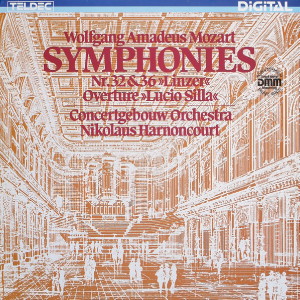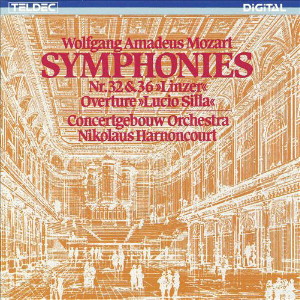 |
1 LP -
6.43108 AZ - (p) 1985
|
 |
| 1 CD -
8.43108 ZK - (p) 1985 |
|
| Wolfgang
Amadeus Mozart (1756-1791) |
|
|
|
|
|
|
|
Symphonie Nr. 36 C-dur, KV
425 "Linzer"
|
|
39' 32" |
|
- Adagio - Allegro spiritoso
|
11' 05" |
|
A1 |
- Andante
|
14' 18" |
|
A2 |
- Menuetto
|
3' 14" |
|
A3 |
| - Presto |
10' 55" |
|
B1 |
Symphonie
(Overture) Nr. 32 G-dur, KV 318
|
|
8' 25" |
|
- Allegro spiritoso
|
3' 05" |
|
B1 |
| - Andante |
3' 22" |
|
B2 |
- Tempo primo
|
1' 58" |
|
B3 |
| Ouvertüre
zu "Lucio Silla", KV 135 |
|
7' 58" |
|
- Molto allegro
|
3' 45" |
|
B4 |
| - Andante |
2' 43" |
|
B5 |
| - Molto allegro |
1' 30" |
|
B6 |
|
|
|
|
| CONCERTGEBOUW ORCHESTRA,
AMSTERDAM |
|
| Nikolaus
Harnoncourt, Dirigent |
|
|
Luogo
e data di registrazione
|
Concertgebouw,
Amsterdam (Olanda) - giugno 1984 (KV
425, 318) - novembre 1984 (KV 135)
|
|
Registrazione
live / studio
|
| studio |
Producer
/ Engineer
|
-
|
Prima Edizione CD
|
| Teldec
- 8.43108 ZK - (1 cd) - 56' 23" - (p)
1985 - DDD |
Prima
Edizione LP
|
Teldec - 6.43108
AZ - (1 lp) - 59'
23"
- (p) 1985 -
Digital
|
|
|
Notes
|
The last
three symphonies that Mozart wrote in
Salzburg - K.318, K.319 and K.338 - make
up a group of works whose parts are
connected with one another by
relationships and contrasts. In
their original versions they are all
three-movement works without a minuet.
The opening movements lack the
repetition of the exposition customary
in sonata form, and in K.319 and K.338
the middle section of these movements
does not consist of motif development,
but is rather a modulation section
with new subjects, which are treated
contrapuntally in K.319, while in K.338
they are treated dramatically, i.e
with operatic resources. Between K.318
and K.319 there is the greatest
possible contrast in inflexion: the
former is full of theatrical pathos,
while the latter is endowed with
chamber-musical finesse. K.338 seems
like an oversized
intensification of the theatre tone of
the first three symphonies and thus
points straight back to
the ,,Paris“ Symphony K.297. The
common model for the three works
however is not the occasional
composition of the ,,Paris“, but the
Italian opera sinfonia. It
seems as though Mozart once more
sought to achieve a synthesis of Italian
and Austrian traditions before finally
turning to the Austrian symphonic
model in Vienna.
This is clearest in K.318 (which is
dated Salzburg, 26th April 1779, i.e.
three months after Mozart’s return
from Paris):
on the surface aa work full of pomp
and noise, scored for an
unusually large orchestra (four
horns); in formal terms an opera
sinfonia of the type in which the
three parts (fast-slow-fast)
flow into one another without a break
and in which the third part is a
repeat of the first.
But in Mozart`s hands this model
undergoes a transformation affecting
both form and content. The statement
of the themes is followed by intensive
development of the pathetic, operatic
opening motif, which is already almost
ubiquitous in the exposition, and only
at the very dramatic end of this
development does the dance-like,
idyllic andante commence.
After another very dramatic transition
the third part brings the reprise of
the first allegro, starting with the
second subject; the main subject is
then repeated as a coda. The result is
that the overall form becomes
exceptionally dynamic and the symphony
unusually compact (the overture-like
brevity obviously plays a rôle
here). The whole work seems like one
great scene dominated by the pathetic
opening motif, which is localized, as
it were, by the bucolic tones of the
andante - a classic
example of the enhancement of a
tradition not only in terms of form,
but of content too.
Mozart composed his Symphony in C
major K.425 at the
beginning of`November 1783 in Linz,
where he was staying at the house of
Count Johann Joseph
Anton Thun on his way
back from visiting his father in
Salzburg to Vienna. As he told his fathen,
an “Academy” was planned for 4th
November in the Linz municipal theatre.
“As I haven’t got a single symphony
with me, I’m writing a
new one at breakneck
speed - it has to be finished by then.”
Joseph Haydn, on whom
Mozart modelled himself as a quartet
composer, comes to exercise influence
on the younger composers symphonic
writing, too, in the “Linz” Symphony.
For the first time, Mozart places a
slow introduction before the first
movement. But the
allegro spiritoso with its second
subject that opens unexpectedly in E
minor, the andante that takes on a dark
colouring soon after its songlike
beginning, the minuet and the finale
would also not have
been written in the same way if Mozart
had not studied Haydn’s
works.
“Lucio Silla", the last opera Mozart
wrote for Italy, receivce its firt
performance on 26th December 1772 in
Milan’s Theatro Ducale.
Mozart already had the overture, a
three-part sinfonia
with almost melancholy overtones in
the middle movement, in his luggage
when he set out from Salzburg to Milan
at the end of`October.
Hans
Christoph Worbs
Translation: Clive Williams
|
|
Nikolaus
Harnoncourt (1929-2016)
|

|

|
|